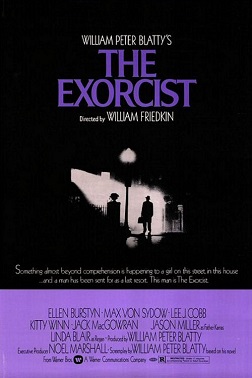 Join me as I write about some spooky things I have experienced in the recent past (broadly defined). First up we have William Friedkin's film, which I saw last year when it was re-released to mark the 50th anniversary of its original appearance. If you have any interest in films you have probably seen it already, and if you haven't you are still probably familiar with its basic premise (girl is possessed by a fiend of hell, priests try to exorcise her). This was a rewatch for me, but even for a second time the film retains its unnerving power. It is also one of the most pro-Catholic films I have ever seen, with a deep reverence for the mysteries of the Church and a presentation of its priest characters as heroic figures even as they grapple with their own doubts and crises of faith.
Join me as I write about some spooky things I have experienced in the recent past (broadly defined). First up we have William Friedkin's film, which I saw last year when it was re-released to mark the 50th anniversary of its original appearance. If you have any interest in films you have probably seen it already, and if you haven't you are still probably familiar with its basic premise (girl is possessed by a fiend of hell, priests try to exorcise her). This was a rewatch for me, but even for a second time the film retains its unnerving power. It is also one of the most pro-Catholic films I have ever seen, with a deep reverence for the mysteries of the Church and a presentation of its priest characters as heroic figures even as they grapple with their own doubts and crises of faith.
I was struck by the way the film presents its narrative, using a visual equivalent of music going quiet-loud-quiet to create emotional peaks and then to release the tension. At times though this left me wondering how scenes resolved after the director called "Cut". Consider a scene in which Ellen Bustyn as the possessed girl's mother runs into her daughter's bedroom when she hears her screaming and is confronted by the terrified child on a bed that is shaking around violently. After a moment in which we take in the horror of what is happening the scene cuts to something else, which left me wondering how the episode played out… did the bed gradually stop shaking after everyone screamed for a bit? Did the mother pull the girl off the bed and take her to another room, providing a temporary respite? Did everyone pile onto the bed to put a stop to its gallop? Or did they all stand there screaming until the morning?
I also found myself thinking about the decision to have a different actor than Linda Blair provide the demon voice when the girl is in full possessed mode. That's a common device used in dramas about possession but I think it is always a mistake. If a lord of the abyss were to possess me he would still be talking with my vocal chords. And I think it would be more terrifying to have the possessed girl mouthing hellish obscenities with the teenage Linda Blair's voice than that of some 60 year old chain-smoker.
But what of real-life exorcism cases? In the film the exorcists are the heroes, saving the girl from the demonic prince. Even the film's secular psychiatrists seem to think that calling in the exorcists is a good idea (while being clear to assert that exorcism doesn't work for the reasons the exorcists think it does). In real life however exorcism is a deeply dangerous procedure and can pander to and amplify the delusions that the supposedly possessed person labours under. The film also gives the impression that exorcism is a one-and-done affair, but real exorcisms seem to be a much more protracted and episodic. There is the particularly disturbing case of Annaliese Michel (who inspired the track 'Annalisa' on the first Public Image Ltd. album), a disturbed German woman who underwent 67 exorcism sessions, each of several hours duration, over a period of 10 months; her parents abandoned psychiatric treatment for her and relied solely on the exorcists. Sadly, Michel died of malnutrition and dehydration, with her parents and the exorcists being convicted of manslaughter. I did find myself wondering if films like The Exorcist have the unfortunate side effect of amplifying beliefs that ultimately lead to tragic outcomes like Michel's death.
image source:
The Exorcist poster (Wikipedia)
No comments:
Post a Comment